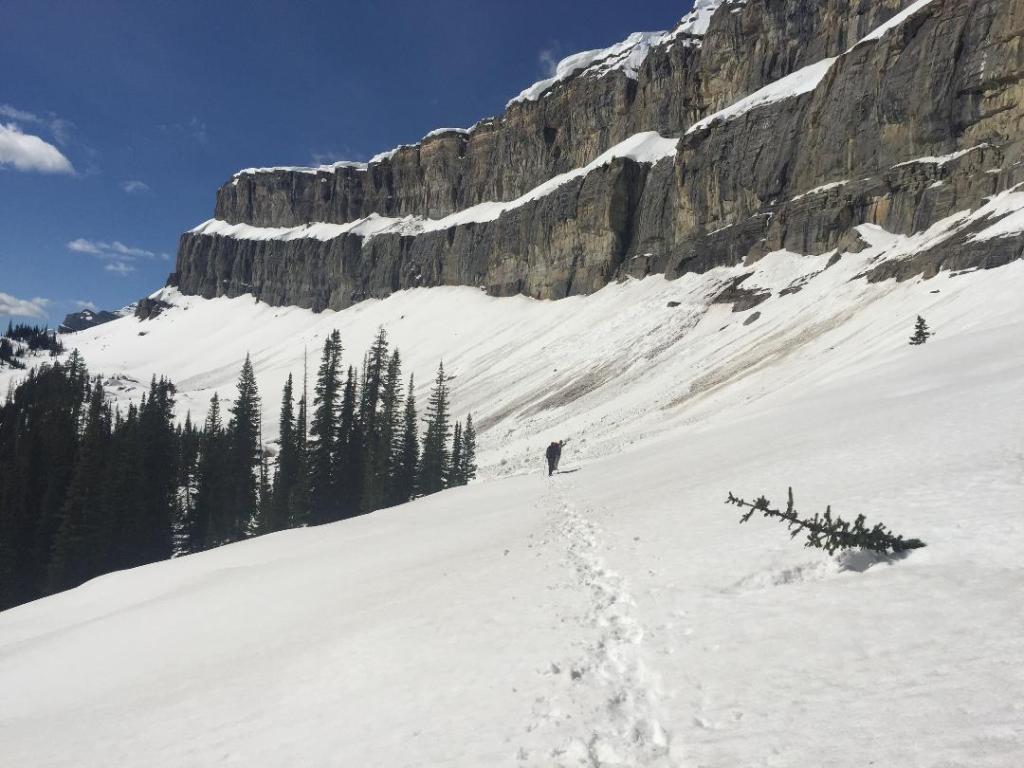Top photo by Mike Moore.
Due to the COVID-19 pandemic the mass start for the 2020 Open was cancelled, a decision I made not to avoid the modest social contact at the start point but rather to discourage the still inherently problematic matter of folks traveling to Montana from out of state. A still robust ~14 people took the start, with beginning dates spread out over roughly a week either side of Saturday, May 23. The starting point was the Point Pleasant state forest campground south of Swan Lake; the end point the Gibson Reservoir boat ramp.
Conditions were unique, even when measured over the past 9 years of weather and snowpack. An overall average snowpack in the Bob lingered further than usual through a cool April, and was fattened substantially by several big storms in mid-May. Mid elevation snow was more robust than any year of the Open save 2014, and sunny temperatures had every hiker contending with the possibility of wet avalanches during alpine stretches. Rivers saw the delayed impacts of wide temperature variations over the week of the Open, with the South Fork of the Flathead peaking at nearly 20,000 cfs on May 21, diving down to 8,000 by May 25, then climbing back to 12,000 48 hours later. Nearly all participants avoided the highest water, and several packrafters hit the low point just right for floats of the West and South Forks of the Sun, but overarching conditions made major river fords unlikely without either a packraft or a pack bridge.
As is often the case, these crossings proved to be the major guide points of route selection, with the boat-less crossing the South Fork of the Flathead at either Meadow Creek gorge or Black Bear, and then the North Fork of the Sun at Gates park or the Klick Ranch. Several hikers with packrafts floated the West and South Forks of the Sun River, and then Gibson Reservoir. One packrafter floated Bunker Creek early on, and then the upper White while in transit to White River Pass. In his words: “The short floats on Bunker Creek and the Upper White were both exciting and provided welcome rest to my haggard feet, but did not serve to expedite travel…The Upper White was skinny and fast with great views and a ton of wood. The second portage was a logjam maze that took me 20 min to navigate. In total there was maybe 10 portages, but none as shitty as that big jam. I am very pleased to have explored these sections and gain experience in skinnier water with high wood stress, but I can’t see myself doing them again.” Nine years of the Open have shown that the major rivers, when they align even vaguely with the overall direction of travel, can vastly increase overall speed. The second class of major creeks in the Bob are generally floatable in late May, but also generally have enough obstacles (wood, rapids) that they are rarely objectively faster than the pure foot alternative.
That said, relatively few hikers prioritized speed this year (though the speediest clocked close to 100 miles in 40 hours total time), with most taking at least one high alpine traverse for aesthetic and exploratory reasons. Sections of the greater Pagoda ridge were most common, along with Larch Hill and the Chinese Wall, while a few folks did long ridge walks going east from the Swan Crest. Hikers exited both Rock and Moose Creeks to the North Fork of the Sun, as well as going over White River Pass. Cornice collapses and wet slide avoidance were consistent navigational issues up high, with many hikers either camping such that they crested passes early in the morning, or pushing on into the dark and climbing through the alpine in the middle of the night. Warm temps made this far from a failsafe approach; as one hiker wrote: “It was 5:30 a.m. at 6,000 feet and I was in a t-shirt sweating.” Leaving the summer trails proved essential for safe route finding.
Traditionally big fords such as Moose Creek and the West Fork of the Sun went without a hitch, due to either the window of low water or the overall experience of the most of the hikers, or perhaps both. Though several novice teams completed the traverse, those folks were without exception long time aspirants and well prepared. Back in early April the pandemic made the public running of an event so seemingly risky something to question, but conservative choices seemed to have been the default this year, a recognition of both the hazardous conditions on the ground and the extraordinary conditions writ large. As one hiker wrote: “Despite many varied and unprecedented complaints with 2020 thus far, the Open felt like an unmitigated success and continues to serve as a substantial anchor for my year. This trip was highlighted by the expected good company, a Wall ramble charged by a slightly risky line necessary to maintain full view of dramatic snowfalls, and the ever-lovely North Fork of the Sun bursting into spring.”
I did not participate in the Open this year, opting instead for a trip on totally new ground for me; the Middle Fork of the Salmon River. This explains the less specific and personal nature of this report, as the Open is less mine than ever. Recognizing both the continued draw of the Bob, and of the many great possibilities elsewhere in the American West, 2021 will see two Bob Opens: the traditional late May Bob Marshall traverse will continue to celebrate the place I am other have come to love so well, and an early May traverse of the Frank/Selway complex will provide a longer, less known, and potentially more technical option for those so inclined.
Expect course announcements in early 2021.

Leave a reply to DaveC Cancel reply